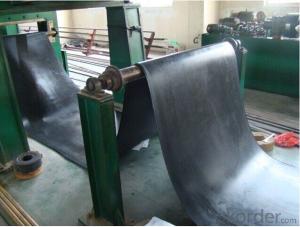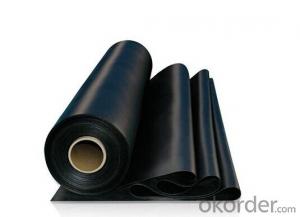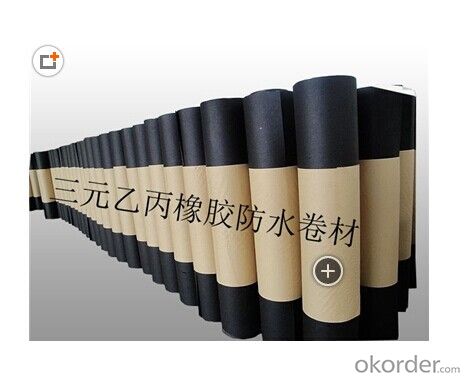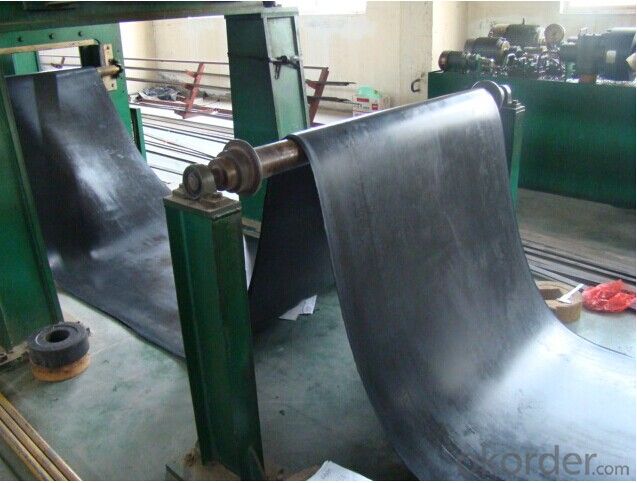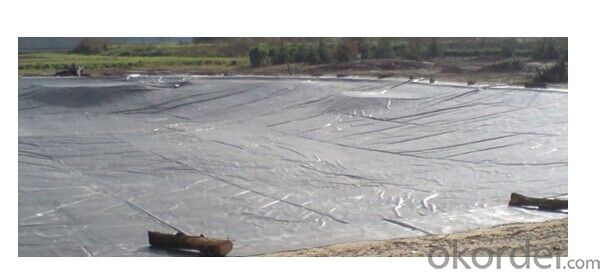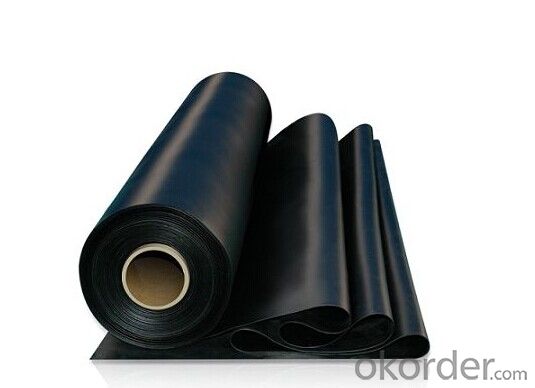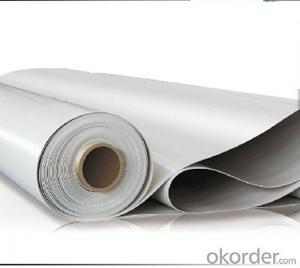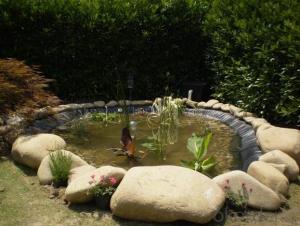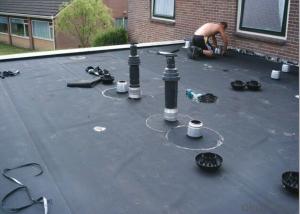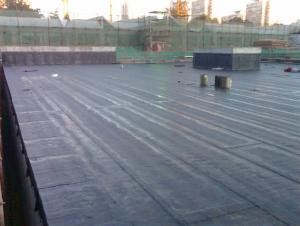EPDM Rubber Waterproof Membrane for Roof Use
- Loading Port:
- Qingdao
- Payment Terms:
- TT or LC
- Min Order Qty:
- 2000 m²
- Supply Capability:
- 300000 m²/month
OKorder Service Pledge
OKorder Financial Service
You Might Also Like
EPDM Waterproof Membrane
Product characteristics for EPDM Waterproof Membrane
1.Excellent anti-aging performance, service life can reach 50 years;
2.High elongation, high tensile strength, heat treatment size change small;
3.Plant root penetration resistance is good
4.Good low temperature flexibility
5.Application is convenient, overlapping is firm and reliable, no environmental pollution;
6. Resistance to chemical corrosion, can be applied to special places;
7.Maintenance is convenient, the cost is low
Uses for EPDM Waterproof Membrane
Widely used in roofs, basement, toilet ,swimming pool, and all kinds of industry and civil building waterproofing, reservoir, vivicism, bridge, underground, tunnel and dam waterproofing ,especially to the keystone waterproofing projects which is durability, high corrosion resistance and easy deformation
Specification for EPDM Waterproof Membrane
Item | Thick(mm) | Width | Length(m) | Color |
Spe | 1.0—2.0 | 1.2m/2m/3m/4m | 20 | Black |
Deviation | -1 +15 | --1 | Multicolor |
Technical Data for EPDM Waterproof Membrane
Item | value | ||
JL1 | JF1 | ||
Tensile Strength (Mpa) | normal tamperature | 7.5 | 4.0 |
60°C ≥ | 2.3 | 0.8 | |
Elongation at break (%) | normal tamperature ≥ | 450 | 450 |
-20°C ≥ | 200 | 200 | |
Tear Resistance (N) | ≥ | 25 | 18 |
Water impermeability | 30mm | 0.3Mpa | 0.3Mpa |
Cold bending | (°C) ≤ | -40 | -30 |
Heating Shrinking rate | extand << span=""> | 2 | 2 |
shrink << span=""> | 4 | 4 | |
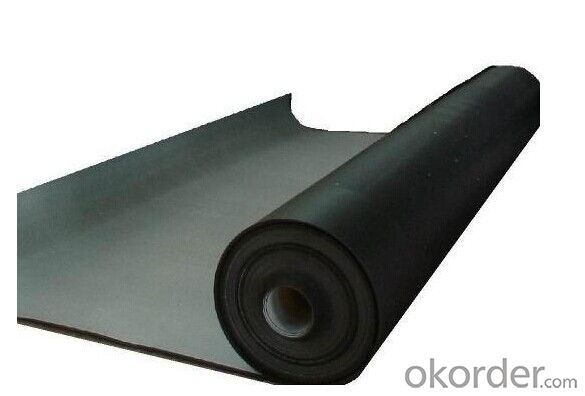
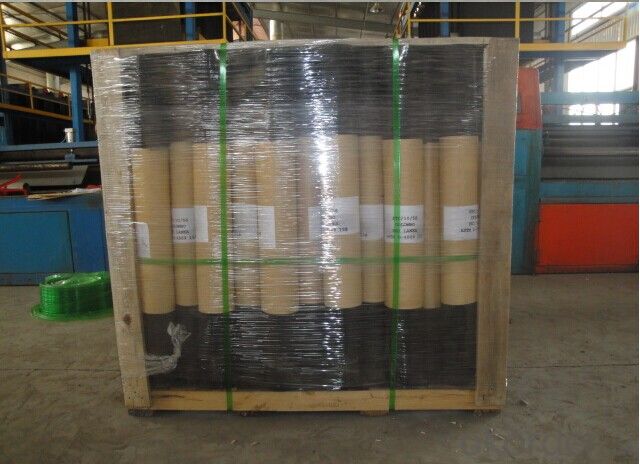
FAQ:
Can you produce 4m width?
Yes, no problem for us. We have four bases in China, largest one in this field.
How many quantity in one 20'' container for 1.2mm and 1.5mm?
480rolls, 11520m2 for 1.2mm and 400rolls, 9600m2 for 1.5mm
Can you provide free samples?
Yes, our samples are free, but express fees usually on buyer's account.
- Q: Is a waterproofing membrane resistant to algae or moss growth?
- Yes, a waterproofing membrane is typically resistant to algae or moss growth. Waterproofing membranes are designed to create a barrier against water infiltration, preventing moisture from seeping into the underlying structure. These membranes are typically made of materials that are not conducive to the growth of algae or moss, such as synthetic polymers or rubberized compounds. Additionally, waterproofing membranes are often treated with additives that inhibit the growth of organic matter, including algae or moss. However, it is important to note that over time, if the membrane is exposed to constant moisture or damp conditions, it may become a breeding ground for algae or moss. Therefore, regular maintenance and cleaning are important to ensure the longevity and effectiveness of the waterproofing membrane.
- Q: Can a waterproofing membrane be used for power plants?
- Indeed, power plants can make use of waterproofing membranes. Waterproofing membranes find widespread use in various settings where the prevention of water penetration is essential, and power plants are no exception to this. Within power plants, there are often sections that come into contact with water, such as cooling towers, wet flue gas desulfurization systems, and other water management systems. Incorporating waterproofing membranes within these areas aids in safeguarding the structures and equipment against water damage, corrosion, and leaks. Furthermore, underground structures like basements or tunnels, which are frequently present in power plants, can also benefit from the application of waterproofing membranes. These membranes act as a reliable barrier against water infiltration, thereby ensuring the durability and longevity of the power plant structures. Consequently, the utilization of a waterproofing membrane emerges as a practical and advantageous solution for maintaining the performance and dependability of power plant facilities.
- Q: Can a waterproofing membrane be used on asphalt surfaces?
- Yes, a waterproofing membrane can be used on asphalt surfaces. Waterproofing membranes are often used to protect various surfaces, including asphalt, from water damage. They create a barrier that prevents water from seeping into the asphalt, reducing the risk of cracks, deterioration, and other forms of damage caused by moisture.
- Q: Can a waterproofing membrane improve energy efficiency?
- Yes, a waterproofing membrane can improve energy efficiency. By preventing water infiltration and moisture buildup, it helps to maintain the integrity of the building envelope, reducing the risk of air leaks and heat loss. This can result in improved insulation performance, reduced energy consumption for heating or cooling, and ultimately contribute to overall energy efficiency.
- Q: Can a waterproofing membrane be used for bridges or parking decks?
- Yes, a waterproofing membrane can be used for bridges or parking decks. Waterproofing membranes are commonly used in these structures to protect them from water damage and extend their lifespan by preventing water infiltration and corrosion. The membrane acts as a barrier, preventing water from seeping into the structure and causing structural deterioration or compromising the integrity of the bridge or parking deck.
- Q: Are waterproofing membranes resistant to hail damage?
- Yes, waterproofing membranes are generally resistant to hail damage. They are designed to withstand various weather conditions, including hailstorms, without getting damaged or compromised.
- Q: Can a waterproofing membrane be used on both interior and exterior walls?
- Yes, a waterproofing membrane can be used on both interior and exterior walls. The membrane helps prevent water penetration, providing protection against moisture for both sides of the wall.
- Q: Can waterproofing membranes be used on shower walls?
- Indeed, waterproofing membranes are suitable for application on shower walls. They play a crucial role in shower construction by preventing water leakage and safeguarding adjacent areas from potential harm. These membranes act as a barrier, effectively blocking water infiltration into the shower's structural components. Typically, they are installed behind the tile or other wall coverings, serving as an additional protective layer. Designed to be pliable, long-lasting, and moisture-resistant, waterproofing membranes guarantee the preservation of watertight shower walls and safeguard against any water-related harm.
- Q: Can a waterproofing membrane be used for a shower enclosure?
- Yes, a waterproofing membrane can be used for a shower enclosure. These membranes are specifically designed to prevent water from seeping through the walls and floor, ensuring a watertight seal. They are commonly used in construction and renovation projects to protect areas prone to moisture, such as bathrooms and showers.
- Q: Can a waterproofing membrane be used for historical buildings?
- Historical buildings can indeed benefit from the use of a waterproofing membrane. While it is vital to maintain the architectural integrity and historical significance of these structures, it is equally important to shield them from water damage. Waterproofing membranes offer an effective solution to prevent water infiltration, which can lead to decay or deterioration. These membranes can be applied to various surfaces, including roofs, walls, and foundations, without compromising the visual appeal of the historical building. It is essential to select a waterproofing membrane that is suitable for historical buildings, taking into account factors such as breathability, compatibility with existing materials, and adherence to preservation guidelines. By carefully choosing and correctly installing a waterproofing membrane, historical buildings can be safeguarded against moisture-related problems, ensuring their longevity and continued preservation.
Send your message to us
EPDM Rubber Waterproof Membrane for Roof Use
- Loading Port:
- Qingdao
- Payment Terms:
- TT or LC
- Min Order Qty:
- 2000 m²
- Supply Capability:
- 300000 m²/month
OKorder Service Pledge
OKorder Financial Service
Similar products
Hot products
Hot Searches
Related keywords

